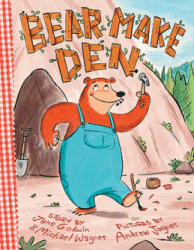Bear Make Den
Jane Godwin & Michael Wagner
Andrew Joyner
Allen & Unwin, 2016
32pp. hbk., RRP $A24.99
9781760110017
Bear has decided it’s time to make a new den. With his trusty how-to book, he finds a suitable hillside and sets to work digging out something that is custom made and therefore should be just right. But no – it’s not. And so guided by necessity being the mother of invention, he starts to fill it with the essentials of life – chairs, table, bed, a lamp … But still there is something missing, It is not as he had dreamed. Even a huge cake, a game and art on the walls does not bring the feel he wants. Can he work out what is missing and can he find it?
Despite Bear’s despair, this is a joyful story about what makes a house a home that little people will love as they try to work out what it is that is missing from Bear’s den and start to investigate the difference between needs and wants. By carefully looking at the pictures like two chairs not one; bunk beds not a single; a game needing two players- they may well be able to determine what it is that is missing before Bear himself does. How is Bear feeling? Will he give up and give in? If he does, will he be happy? What are the clues in the pictures that show he is resilient and will persevere?
Working on Glasser’s Five Basic Needs theory (survival and safety; freedom of choice; power and recognition; love and belonging; fun and satisfaction) young children can make suggestions that might satisfy Bear’s needs as they answer the question “Can he live without this?” They could then transfer what they’ve learned about Bear’s needs into what it is they need and how those can be satisfied. Just as Andrew Joyner’s playful pictures bring the simple text to life, I can envisage a large wall display of Needs vs Wants as the children determine what are the essentials in their lives and search magazines and other images to illustrate their statements classifying them according to whether they are necessities or desirables. (Look here for some starter ideas .)For those slightly older, this could then expand into how the basic needs are met for children around the world (if indeed they are) and from that a poem such as Kids Are Kids could be crafted.
The best picture books are deceptively simple – they are a perfect marriage between text and illustrations based on a simple premise that has wide application and then hidden depths so that each time the story is read or shared, there is something new to discover. This book meets all those criteria from cover to endpapers.
